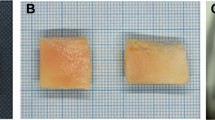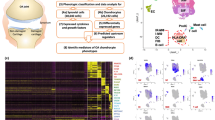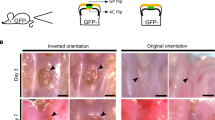Abstract
Proteoglycans are major components of many extracellular matrices. In cartilage, they provide reversible resistance to compression and exist as molecules with molecular weights (MWs) of 1–3 × 106. There is a central protein core of MWs approximately 2 × 105 (refs 1, 2) with specialized subrogions, one containing mainly the chondroitin sulphate chains3, another most of the keratan sulphate chains4, and a third is a largely globular structure interacting specifically with both hyaluronic acid5 and a link protein6 to form stable aggregate structures such as those identified in human articular cartilage7. In embryonic8 and tissue culture systems9, proteoglycans are isolated as aggregate structures in as little as 5–10 min after synthesis (sulphation) with no nonaggregating precursor detected. However, Heinegård and Hascall have characterized the small proportion of nonaggregating proteoglycan present in bovine nasal septum cartilage and found that it contained more peptide than the aggregating proteoglycan10. Work by Upholt et al.11 has suggested that the MW of unprocessed protein core, synthesized by a wheat-germ translating system from chick sternal cartilage mRNA, is ∼340,000, leaving open the possibility of intermediates. I report here the presence, in some human cartilages, of a proteoglycan population that initially will not aggregate with the hyaluronic acid but subsequently can be chased into aggregate.
This is a preview of subscription content, access via your institution
Access options
Subscribe to this journal
Receive 51 print issues and online access
$199.00 per year
only $3.90 per issue
Buy this article
- Purchase on Springer Link
- Instant access to full article PDF
Prices may be subject to local taxes which are calculated during checkout
Similar content being viewed by others
References
Hascall, V. C. & Riolo, R. L. J. biol. Chem. 247, 4529–4538 (1972).
Oegema, T. R. Jr, Brown, M. & Dziewiatkowski, D. D. J. biol. Chem. 252, 6470–6477 (1977).
Heinegard, D. J. biol. Chem. 252, 1980–1989 (1977).
Heinegard, D. & Axelsson, I. J. biol. Chem. 252, 1971–1979 (1977).
Hascall, V. C. J. supramolec. Struct. 7, 101–120 (1977).
Baker, J. R. & Caterson, B. J. biol. Chem. 254, 2387–2393 (1979).
Bayliss, M. T. & Ali, S. Y. Biochem. J. 176, 683–693 (1978).
DeLuca, S., Caplan, A. I. & Hascall, V. C. J. biol. Chem. 253, 4713–4720 (1978).
Kimura, H. H., Hardingham, T. E., Hascall, V. C. & Solursh, M. J. biol. Chem. 254, 2600–2609 (1979).
Heinegard, D. & Hascall, V. C. J. biol. Chem. 254, 927–934 (1979).
Upholt, W. B., Vertel, B. M. & Dorfman, A. Proc. natn. Acad. Sci. U.S.A. 79, 4847–4851 (1979).
Thompson, R. C. Jr & Oegema, T. R. Jr J. Bone Jt Surg. 61, 407–416 (1979).
Oegema, T. R. Jr, Bradford, D. S. & Cooper, K. C. J. biol. Chem. 254, 10579–10581 (1979).
Oegema, T. R. Jr, Hascall, V. C. & Eisenstein, R. J. biol. Chem. 254, 1312–1318 (1979).
Author information
Authors and Affiliations
Rights and permissions
About this article
Cite this article
Oegema, T. Delayed formation of proteoglycan aggregate structures in human articular cartilage disease states. Nature 288, 583–585 (1980). https://doi.org/10.1038/288583a0
Received:
Accepted:
Issue Date:
DOI: https://doi.org/10.1038/288583a0
This article is cited by
-
The role of aggrecan in normal and osteoarthritic cartilage
Journal of Experimental Orthopaedics (2014)
-
Structural and biochemical abnormalities of articular cartilage in rheumatoid arthritis
Rheumatology International (1990)
-
Synthesis and extracellular assembly of proteoglycans in human articular cartilage
Agents and Actions (1988)
Comments
By submitting a comment you agree to abide by our Terms and Community Guidelines. If you find something abusive or that does not comply with our terms or guidelines please flag it as inappropriate.



